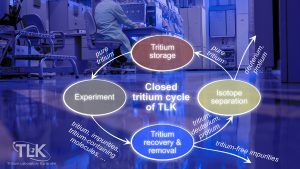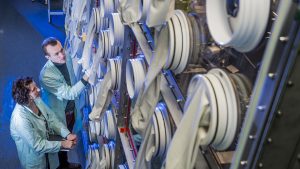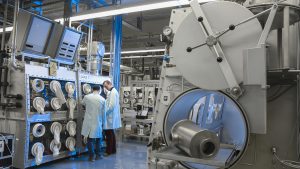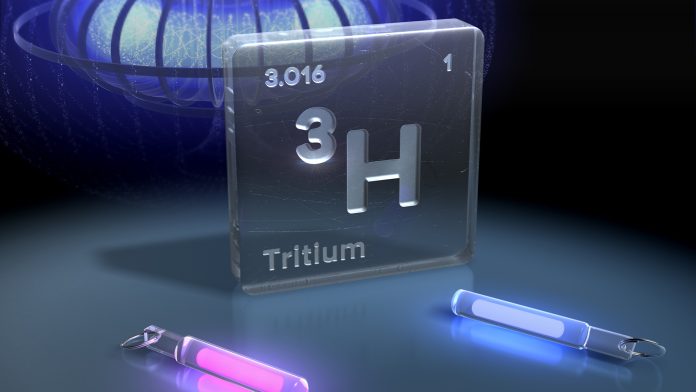Tritium, the radioactive hydrogen isotope, is crucial for nuclear fusion, promising limitless clean energy. For over three decades, the Tritium Laboratory Karlsruhe has pioneered safe tritium handling and fuel cycle research.
Protium, deuterium, and tritium are three isotopes of hydrogen. Although protium and deuterium are stable and plentiful on Earth, tritium stands out as a beta emitter with a half-life of approximately 12.3 years.
It is formed naturally only in the upper atmosphere and, consequently, its procurement heavily relies on technical sources. Tritium is produced in nuclear reactions and is a valuable by-product in fission reactors. Most importantly, tritium emerges as an essential component in the pursuit of commercial fusion power generation. The deuterium-tritium fusion reaction stands out as the foremost and most viable pathway to achieving the goal of limitless, clean energy.
Development of a safe and efficient fuel cycle for fusion reactors
In today’s rapidly evolving fusion landscape, an astonishing variety of confinement types is being explored through numerous public and private experimental initiatives. However, technical requirements and challenges associated with the tritium fuel cycle are largely unaffected whether a magnetic or inertial confinement is chosen.
In any case, tritium must be stored, injected into the reaction location, and the exhaust gas – which is a complex mixture of unburned fuel, helium-‘ash’, other by-products, and many secondary impurities – must be processed efficiently. In addition, an outer loop must be established where tritium, bred through the reaction of fusion-born neutrons with lithium, is purified and prepared for reinjection. In a DEMO-like reactor with a thermal power of approximately 3GW, hundreds of grams of tritium are both consumed in the reactor and generated from lithium daily. This process involves handling a couple of kilograms of tritium as it continuously cycles through the processing loops.

Over 30 years of tritium handling and research at Tritium Laboratory Karlsruhe
The radioactive nature requires one to face challenges in safely and efficiently handling large amounts of tritium. This necessitates dedicated technology advancements that encompass every facet of the tritium cycle, including its production, secure storage, precise detection, and efficient processing.
In the early 1990s, the Tritium Laboratory Karlsruhe (TLK) was founded with the mission to develop the deuterium-tritium fuel cycle for nuclear fusion. Today, the TLK has a handling license for 40g of tritium and currently maintains an extensive stock of about 30g. With this and its extensive infrastructure systems and experimental facilities, TLK is a worldwide unique large-scale research facility. Early pioneering research and development endeavours at TLK targeted the inner fuel cycle of ITER, resulting in the provision of its integrated design. What were once merely experimental systems have now evolved to become the robust backbone of TLK’s closed tritium cycle. These advanced systems permit a multitude of sophisticated experiments with high-purity tritium. With an area of 1,600m² hosting over 20 specialised gloveboxes, many experiments are run in parallel and are set up and dismantled again. This is vital in a rapidly developing environment such as research with and on tritium. TLK is the host for the Karlsruhe Tritium Neutrino Experiment (KATRIN), which has achieved worldwide visibility through its recent successes in direct neutrino mass measurement running since 2018. Until June 2024, more than 1,000 days of tritium circulation were achieved with an unprecedented total throughput of 31kg of tritium (98.5% purity).
In addition to the work for KATRIN and on the fuel cycle for nuclear fusion, TLK conducts research in the areas of astroparticle physics with tritium and fundamental properties of tritiated molecules. Furthermore, TLK is developing techniques and components to overcome the challenges in the handling and processing of tritium on an industrial scale. TLK is leading the development and application of tritium analytics embedded in these processes.
Addressing present technological challenges of tritium
To address challenges related to tritium for future nuclear reactors, tritium research at TLK is organised in four strategic thrusts:
Tritium properties and material interactions
Instead of studying tritium, hydrogen and deuterium can serve as surrogates for physical and chemical properties. However, the use of tritium is inevitable due to complex radiochemistry. Ultimately, there is no substitute for performing the experiments using tritium. Tritium data empowers scientists and engineers to model and design tritium processes and components up to the system level. Ongoing studies of fundamental tritium properties encompass understanding the viscosity of tritium as well as the solubility of tritium in materials. Understanding the latter is paramount for any blanket concept and design.

Tritium and hydrogen analytics and accountancy
Research with and processing of tritium requires dedicated analytical methods. TLK is leading the development and in-field testing of tritium-tailored technologies (e.g. Raman, IR, and beta-induced X-ray spectroscopy systems) for rugged application in accurate process monitoring. Additionally, TLK aims at the development of comprehensive accountancy strategies specifically designed for high-throughput tritium loops in fusion reactors. These are needed to ensure reliable tracking and management of tritium inventory, as it will be mandatory by the regulatory body. Many ongoing tasks are focused on devising tritium analytics and analytical concepts tailored to ITER, the current biggest experimental effort on the path to fusion power. By the nature of TLK’s closed tritium loop, both novel and commercial detectors can be characterised for tritium service under relevant process conditions.

Tritium qualification of processes and scaling-up of systems to technical scale
TLK is bridging the gap between small-scale experimental research and plant-scale process systems. It offers a multitude of experimental rigs for full-tritium qualification of processes, components, and entire systems to public and private research endeavours. Current examples include the development of permeation barrier concepts to reduce tritium migration and the implementation of established and novel isotope separation systems to increase the recycling factor of the tritium plant. A primary research thrust will address the pressing question of the extraction of tritium from the blanket purge gas.
Tritium decontamination, safety and waste management
Finally, TLK is developing end-of-lifecycle solutions for tritium-facing components to reduce contaminated waste. Currently, we establish UV/ozone cleaning methods for the removal of large-area surface contamination and enable in-situ decontamination. In addition, we study decontamination by advanced vacuum furnace treatment.
For a safe, efficient, and economical tritium fuel cycle, these fundamental open questions must be addressed, and a wide range of tritium technologies need to be developed and established. In addition to driving forward technological research, we also need to start training and building the knowledge of the future workforce and tritium experts today. Located in Germany and funded by its Helmholtz Association, TLK stands as a key player in tritium research for Europe. Our team is not just prepared but passionately motivated for the transition from fundamental research toward commercial fusion applications.
Please note, this article will also appear in the 19th edition of our quarterly publication.









